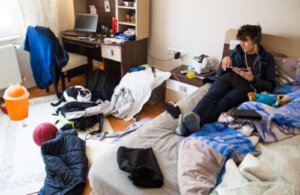My Teenager's Room Is a Mess: What to Do?

What does the panoramic picture of your teenager’s room usually look like? That of many youngsters is one that shows piles of clothes lying on the floor, dirty cups and plates scattered all over the space, papers, old wrappers, and socks that are missing their match. You wonder how they manage to live in absolute chaos and a daily struggle to keep their room clean and tidy. We’ll tell you what to do to deal with this situation.
We’re talking about a situation that’s present in practically every home where there are teenage children. Undoubtedly, it’s one of the aspects that hinders coexistence and gives tension to the communication between parents and children.
For your child, their room is a refuge
The first thing you should know before losing your mind is that during adolescence, your teenager’s room itself has great relevance and meaning for them. It’s much more than a space for sleeping and studying. There, young people begin to develop a personal and independent identity. At some point, your child’s room begins to reflect their inner world, tastes and interests, their lights and shadows, and their doubts and discoveries.
Moreover, it’s a private territory within a home shared with the rest of the family. It’s where they exercise and explore their freedom. There, they satisfy their need for intimacy and, at the same time, take refuge from the threats of the outside world. For this reason, it’s important that adolescents who must share a room have small private spaces within the room. For example, they can be drawers, boxes, or a portion of the closet that the rest of the family doesn’t have access to.
Let’s also keep in mind that the adolescent stage involves a series of physical and psychological changes that create a sense of confusion and general disorder. Therefore, it’s not surprising that their rooms are somewhat disorganized.

How to act?
It’s clear that no one likes to have a space in their house that’s turned upside down. As a mother, you probably perceive hygiene and order as fundamental aspects for a harmonious coexistence. However, now that you understand the importance of your teenager’s room, you’ll understand that the situation isn’t so simple.
Faced with this question, the typical doubts arise: How do I make my child understand that they should clean their room? Should I do it for them? To what extent do I allow them to be messy? Well, let’s see what you can do.
1. Avoid taking 100% responsibility for your child’s room
As we’ve seen, a teenager’s room is more than significant. It’s a territory that corresponds to a personal place. Therefore, taking charge of tidiness and cleanliness isn’t the best option. Nor are you the one who should make decisions regarding the decoration, or put the place in conditions. Disengaging yourself from taking care of this part of the house is an excellent idea to foster a sense of responsibility in them. Although of course, you can help them with some basics and teach them by example to keep the space comfortable.
2. Consider the level of carelessness
There are certain limits that we must take into account when deciding what measures to take. When the clutter is excessive to the point that it makes it difficult to move around the space comfortably or the dirt leaves bad odors, we should take action. If you don’t know how to do it, you can consult a psychologist specialized in adolescence. Although it’s not a conclusive issue, an extremely chaotic room may be a sign of a significant emotional problem.

3. Reevaluate your expectations
Now, if the level of neglect is low to moderate, it’s critical that you reevaluate your own expectations. From your point of view, you may notice that your teenager’s room is a real mess because it looks very different from yours. In this regard, it’s likely that what order means for you doesn’t match up exactly with what it is for your child.
However, that should not be a determining factor in classifying your child’s room as chaos. In fact, the important thing is that the youngster is satisfied with their own space, regardless of the clutter. That is, if they can sleep, study, or engage in leisure activities without problems, you should avoid confrontation.
4. Negotiate with them
It’s common knowledge that negotiating with teenage children is very challenging. Often, communication becomes difficult and we can’t find a way to talk to them without getting into an endless battle. In order to establish agreements, both parties should show some flexibility. For there’s no way to make deals if we assume a rigid and stubborn attitude.
It’s highly likely that they’ll first seek to impose their point of view as absolute. However, once they realize that making agreements will be beneficial to both parties, they’ll assume a less defiant attitude.
All cited sources were thoroughly reviewed by our team to ensure their quality, reliability, currency, and validity. The bibliography of this article was considered reliable and of academic or scientific accuracy.
- Feixa, C. (2005) La habitación de los adolescentes. Papeles del CEIC Universidad del País Vasco/Euskal Herriko Unibertsitatea España. Disponible en: https://ojs.ehu.eus/index.php/papelesceic/article/view/12125
- Parra Jiménez, Águeda, & Oliva Delgado, A. (2002). COMUNICACIÓN Y CONFLICTO FAMILIAR DURANTE LA ADOLESCENCIA. Anales de Psicología / Annals of Psychology, 18(2), 215–231. Recuperado a partir de https://revistas.um.es/analesps/article/view/28421
- Schmidt, V., Maglio, A., Messoulam, N., Molina., MF & Gonzalez. A. (2010) La Comunicación del Adolescente con Sus Padres: Construcción y Validación de Una Escala desde un Enfoque Mixto. Revista Interamericana de Psicología/Interamerican Journal of Psychology – 2010, Vol. 44, Num. 2, pp. 299-311. Universidad de Buenos Aires, CONICET, Argentina. Disponible en: https://www.redalyc.org/articulo.oa?id=28420641011
This text is provided for informational purposes only and does not replace consultation with a professional. If in doubt, consult your specialist.








